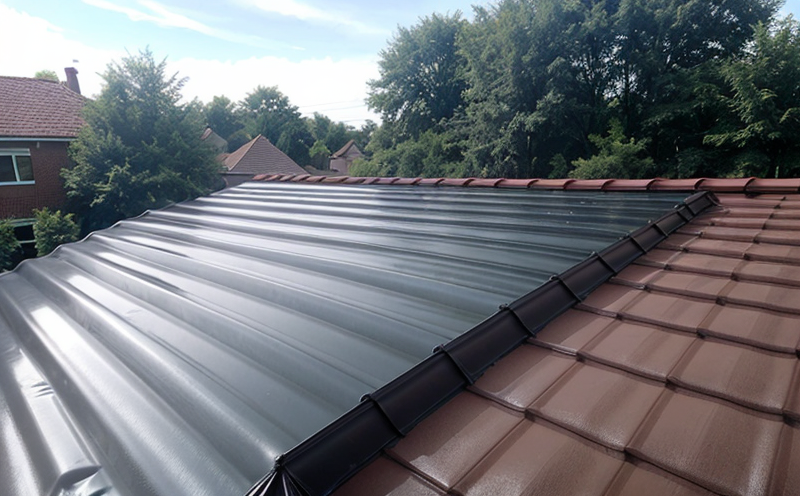ISO 37 Tensile Strength Testing of Elastomeric Membranes
The ISO 37 tensile strength test is a critical procedure used in the evaluation of elastomeric membranes, which are widely employed in roofing and waterproofing applications. This test ensures that the materials meet the required standards for durability, flexibility, and integrity under stress conditions.
Elastomeric membranes play a vital role in constructing resilient roofs and waterproof barriers against water intrusion. These materials must withstand environmental factors such as UV radiation, temperature fluctuations, and mechanical stresses from wind, traffic, and foot traffic. The ISO 37 tensile strength test provides a standardized method to assess the material's ability to resist stretching before failure.
The testing process involves placing an elastomeric sample under tension until it reaches its breaking point. This test helps manufacturers ensure their products meet international quality standards and are suitable for use in various roofing and waterproofing projects.
For accurate results, specimens must be prepared carefully according to specific guidelines provided by ISO 37. Proper specimen preparation is crucial as any deviation can lead to inaccurate readings or misinterpretation of the material's performance. Once prepared, the specimens undergo testing using a tensile tester capable of applying controlled forces.
The test measures both the maximum load at which failure occurs and the elongation at this point. The obtained data provides valuable insights into the mechanical properties of the membrane, including its flexibility and strength. Understanding these characteristics allows for informed decisions regarding material selection during design stages.
By adhering to ISO 37 guidelines, laboratories can provide reliable testing services that contribute significantly towards ensuring product quality compliance with international standards. This not only enhances customer confidence but also fosters trust within the industry by demonstrating commitment to excellence in every aspect of service delivery.
| Sample Preparation | Tensile Testing Parameters | Data Interpretation |
|---|---|---|
| Cleaning and conditioning the specimen according to ISO 37 requirements. | Applying force at a specified rate until failure occurs. | Evaluating maximum load, elongation, and other relevant parameters. |
| Ensuring consistent thickness across all samples for accurate comparisons. | Recording detailed information about the testing process. | Determining compliance with specified standards and expectations. |
| Avoiding contamination of the sample surface before testing begins. | Analyzing the collected data to draw meaningful conclusions. | Providing comprehensive reports summarizing findings and recommendations. |
In summary, ISO 37 tensile strength testing is an indispensable tool for assessing elastomeric membranes used in roofing and waterproofing applications. By following rigorous protocols outlined by international standards bodies like ISO, laboratories can deliver accurate and reliable test results that contribute to maintaining high-quality construction materials.
Applied Standards
The ISO 37 tensile strength testing method is widely recognized for its reliability in evaluating the mechanical properties of elastomeric membranes. This standard ensures consistent and accurate results across different laboratories worldwide, thereby promoting trust and interoperability among stakeholders involved in roofing and waterproofing projects.
- ISO 37:2016 specifies the procedure for determining tensile strength and elongation of vulcanized rubber sheets or films.
- ASTM D4541 covers similar aspects but focuses more on synthetic rubbers rather than natural ones.
The application of these standards guarantees that test results are comparable, repeatable, and reproducible. This consistency is essential for ensuring quality control during manufacturing processes as well as for monitoring product performance post-installation.
Compliance with international standards like ISO 37 not only enhances the credibility of testing laboratories but also facilitates smoother collaboration between suppliers, contractors, and end-users involved in roofing and waterproofing projects. By adhering to these stringent guidelines, labs can offer dependable services that meet global market demands.
Industry Applications
The ISO 37 tensile strength testing method finds extensive application in the building and infrastructure sector, particularly within roofing and waterproofing industries. Here are some key areas where this test plays a crucial role:
| Application Area | Description |
|---|---|
| Reroofing projects | Evaluating the durability of existing membranes before replacement. |
| New construction | Assessing new materials intended for use in fresh installations. |
| Maintenance programs | Monitoring long-term performance to identify potential issues early. |
| Inspection audits | Verifying compliance with specified standards and expectations. |
The test results obtained through ISO 37 play a pivotal role in these applications by providing objective evidence of material performance. This information is invaluable for decision-makers when selecting appropriate products or assessing the effectiveness of current installations.
Furthermore, compliance with international standards like ISO 37 fosters better communication between various parties involved in roofing and waterproofing projects. It ensures that all participants are working towards common goals based on universally accepted criteria.
Competitive Advantage and Market Impact
- Enhanced Product Quality: By adhering to ISO 37, manufacturers can ensure that their products meet the highest quality standards. This enhances brand reputation and customer satisfaction.
- Informed Decision-Making: Accurate test results allow architects, engineers, and contractors to make well-informed decisions about material selection for roofing and waterproofing projects.
- Increased Confidence: Compliance with international standards builds trust among clients, suppliers, and regulatory bodies.
- Market Leadership: Providing reliable testing services contributes to establishing a laboratory as a leader in its field, attracting more business opportunities.
The demand for high-quality roofing and waterproofing materials continues to grow globally. Laboratories offering ISO 37 tensile strength testing services have a competitive edge by delivering precise, consistent results that meet international standards. This positions them as trusted partners in the building and infrastructure sector, driving market growth through reliable service offerings.





